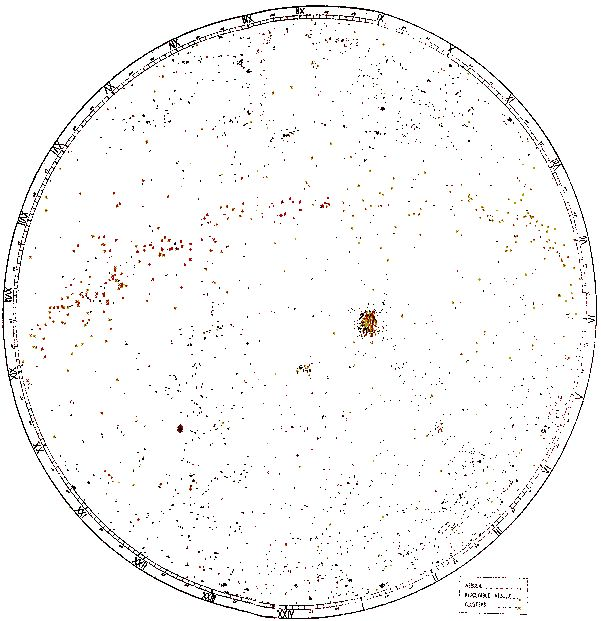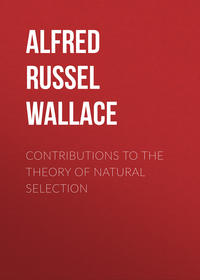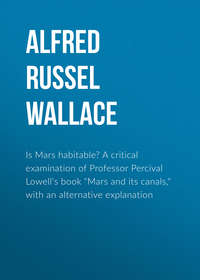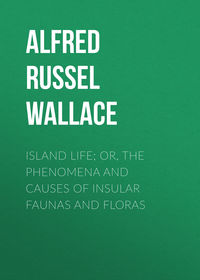 полная версия
полная версияMan's Place in the Universe
Of course there may be, and probably are, other universes, perhaps of other kinds of matter and subject to other laws, perhaps more like our conceptions of the ether, perhaps wholly non-material, and what we can only conceive of as spiritual. But, unless these universes, even though each of them were a million times vaster than our stellar universe, were also infinite in number, they could not fill infinite space, which would extend on all sides beyond them, so that even a million million such universes would shrink to imperceptibility when compared with the vast beyond!
Of infinity in any of its aspects we can really know nothing, but that it exists and is inconceivable. It is a thought that oppresses and overwhelms. Yet many speak of it glibly as if they knew what it contains, and even use that assumed knowledge as an argument against views that are unacceptable to themselves. To me its existence is absolute but unthinkable—that way madness lies.
'O night! O stars, too rudely jarsThe finite with the infinite!'I will conclude with one of the finest passages relating to the infinite that I am acquainted with, from the pen of the late R.A. Proctor:
'Inconceivable, doubtless, are these infinities of time and space, of matter, of motion, and of life. Inconceivable that the whole universe can be for all time the scene of the operation of infinite power, omnipresent, all-knowing. Utterly incomprehensible how Infinite Purpose can be associated with endless material evolution. But it is no new thought, no modern discovery, that we are thus utterly powerless to conceive or comprehend the idea of an Infinite Being, Almighty, All-knowing, Omnipresent, and Eternal, of whose inscrutable purpose the material universe is the unexplained manifestation. Science is in presence of the old, old mystery; the old, old questions are asked of her—"Canst thou by searching find out God? Canst thou find out the Almighty unto perfection? It is as high as heaven; what canst thou do? deeper than hell; what canst thou know?" And science answers these questions as they were answered of old—"As touching the Almighty we cannot find Him out."'
The following beautiful lines—among the latest products of Tennyson's genius—so completely harmonise with the subject-matter of the present volume, that no apology is needed for quoting them here:—
(The Question)Will my tiny spark of beingWholly vanish in your deeps and heights?Must my day be dark by reason,O ye Heavens, of your boundless nights,Rush of Suns and roll of systems,And your fiery clash of meteorites?(The Answer)'Spirit, nearing yon dark portalAt the limit of thy human state,Fear not thou the hidden purposeOf that Power which alone is great,Nor the myriad world, His shadow,Nor the silent Opener of the Gate.'INDEX
Adrianus Tollius on stone axes, 203.
Air criminally poisoned by us, 260.
Albedo explained, 162.
Algol and its companion, 39;
change of colour of, 41.
Allen, Prof. F.J., on living matter, 193;
on importance of nitrogen, 195;
on physical conditions essential for life, 196.
Alpha Centauri, nearest star, 74.
Ammonia, importance of, to life, 195.
Anaximander's cosmic theory, 2.
Angles of a minute and second, 80.
Arcturus, rapid motion of, 172.
Argument of book, summary of, 310.
Astronomers, the first, 2.
Astronomy, the new, 24.
Astrophysics, a new science, 32.
Atmosphere, qualities requisite for life, 210;
requisite composition of, 212;
aqueous vapour in, 214;
and life, 243;
effects of density of, 245;
a complex structure, 259;
its vital importance to us, 260.
Ball, Sir R., on dark stars, 143;
Time and Tide, 233.
Barnham, S.W., on double stars, 123.
Blue of sky due to dust, 251.
Boeddicker's map of Milky Way, 164.
Brewster, Sir D., against Whewell, 15.
Campbell, Prof., on spectroscopic binaries, 125;
on uncertainty of sun's motions, 179;
on number of binary systems, 286.
Carbon compounds, vast numbers of, 194.
Carbonic acid gas essential for life, 196.
Central position of sun, importance of, 305.
Chaldeans the first astronomers, 2.
Chalmers Dr., on plurality of worlds, 13.
Chamberlin, T.C., origin of nebulæ, 120;
on stellar disruption, 186.
Chromosphere, the sun's, 107.
Clerke, Miss A.M., on limits of star system, 138;
on Milky Way, 158, 160;
on solar cluster, 165;
on uncertainty of the sun's motion, 177.
Climate, persistence of mild, 222.
Clouds, importance of, to life, 248.
Clusters in relation to Galaxy, 67.
Comte, on impossibility of real knowledge of the stars, 25.
Conclusions of the book, 317;
bearing of, on science and on religion, 319.
Corona of sun, 108.
Criticisms of article in Fortnightly Review, 168, 180.
Darwin, Prof. G., on meteoritic hypothesis, 133;
on origin of moon, 233;
on instability of annular systems, 295.
Day and night, uses of, 215.
Diagrams of star-distribution, 62, 66.
Diffraction-gratings, 30.
Disruption of stellar bodies, 187.
Doppler principle, the, 37.
Double stars, evolution of, 123;
not fitted for life, 286.
Dust, importance of, 249.
Dust-free air, results of, 254.
Earth, first measured, 5;
in relation to life, 218;
the only habitable planet, 262;
cannot retain hydrogen, 264;
supposed extreme conditions of, 271.
Earth's mass, how related to life, 265.
Ecliptic, obliquity of, in relation to life, 219.
Electricity, effects of atmospheric, 257;
atmospheric, how caused, 258.
Elements, change in spectra of, 129;
in the sun, 184;
in meteorites, 185;
in organic structures, 201.
Empedocles an early astronomer, 3.
Eudoxus on motions of planets, 3.
Evolution of the stars, 128.
Explanations of life-processes, 202.
Faculæ of sun, 105.
Fisher, Rev. O., on oceanic basins, 234;
on thin sub-oceanic crust, 237.
Fizeau measures speed of light, 79.
Flammarion, C., on universality of life, 274, 281.
Fontenelle on plurality of worlds, 9.
Galileo on star measurement, 74.
Geological climates, 222.
Geologists on duration of sun's heat, 275.
Germinal vesicle, M'Kendrick on, 202.
Gill, Sir D., on systematic star-motions, 178.
Globular clusters, stability of, 126;
and variables, 127.
Gore, Mr. J.E., on stars in Galaxy, 60;
on mass of binary stars, 97;
on remoteness of bright stars, 140;
on limits of star system, 145;
on limited number of stars, 151;
on life on planets of other suns, 282, 289.
Gould on solar cluster, 165.
Gould's map of Milky Way, 164.
Gravitation, motions produced by, on Lord Kelvin's hypothesis, 298.
Haliburton, Professor W.D., on proteids, 200.
Heat and cold on earth's surface, 207.
Heat-supply, our long-continued, accounted for, 305.
Herschel, Sir J., on Milky Way, 50;
on limits of the star-system, 147.
Heliometer, description of, 89.
Huggins, Sir W., on spectra of stars, 32;
measures radial motion, 37.
Huxley, Prof., on protoplasm, 198;
on duration of life, 278.
Hydrogen, why not in atmosphere, 240;
escapes from earth, 264.
Infinity, unknowable, 323;
Proctor on, 324.
Jupiter's satellites show speed of light, 79.
Kapteyn on solar cluster, 166.
Kelvin, Lord, on the sun's age, 279;
on a suggested primitive form of star-system, 298.
Kirchhoff, discovers spectrum-analysis, 28.
Laws of matter uniform throughout universe, 187.
Leaves, importance of, 197.
Lee, Dr., on origin of double stars, 123.
Lewis, on remote bright stars, 141.
Life, unity of organic, 189;
definitions of, 191;
conditions essential for, 206;
water essential for, 210;
atmosphere for, 210;
dependent on temperature, 218;
now improbable in stars, 288;
conditions essential for, summarised, 314.
Life-processes, explanations of, 202.
Light, velocity of measured, 79;
necessity of solar, 209;
from sky due to dust, 252.
Light-journey explained, 75.
Light-ratio shows stars to be limited, 152.
Living bodies, essential points in, 192.
Lockyer, Sir. N., on inorganic evolution, 117;
on evolution of stars, 130;
on Milky Way, 159;
on position of solar system, 161.
Luigi d'Auria on stellar motion, 306.
M'Kendrick, Prof., on germinal vesicle, 202.
Magnetism and sun-spots, 106.
Man, Shakespeare on, 322.
Mars, has no water, 266;
excessive temperatures on, 267.
Matter of universe uniform, 183.
Maunder on dark stars, 143.
Maxwell Hall, Mr., on star-motions, 178.
Measurement of star-distances, 85;
difficulty of, 86.
Mercury not habitable, 266.
Meteorites, elements in, 185;
not primitive bodies, 186.
Meteoritic hypothesis, 113;
Proctor on, 114;
explains nebulæ, 116;
Dr. Roberts on, 119.
Milky Way, the, 48;
form of, 51, 159;
description of, 52;
telescopic view of, 57;
stars in relation to, 59;
Mr. Gore on, 60;
density of stars in, 61;
clusters and nebulæ in relation to, 67;
probable distance of, 96;
forms a great circle, 157, 162;
Prof. Newcomb on, 158;
probably no life in, 284;
diagrams of, 300;
revolution of, important to us, 307.
Million, how to appreciate a, 82.
Minchin, G.M., on radiation from stars, 290.
Monck, Mr. W.H.S., on non-infinity of stars, 144;
on uncertainty of sun's motion, 177.
Moon, why no atmosphere, 263.
Moon's supposed origin, 233.
Motion, in line of sight, 35.
Motions, imperceptible, 39.
Nebulæ, with gaseous spectra, 43;
in relation to Galaxy, 66;
distribution of, 69;
many forms of, 70;
gaseous, 71;
meteoritic theory of, 116;
planetary and annular, 175;
Dr. Roberts on spiral, 117, 174;
Chamberlin on origin of, 120.
Nebular hypothesis, 98, 111;
objection to, 112.
Newcomb, Prof. S., on star distribution, 61;
on parallax of stars, 94;
on stability of star clusters, 126;
on scarcity of single stars, 128;
on limits of star system, 138;
on Milky Way, 158, 160;
on solar cluster, 167;
on star velocities, 171;
on average small mass of stars, 285;
on star-motions, 297.
Newton, Sir Isaac, on sun's habitability, 9.
Nichols, E.F., on heat of stars, 290.
Nitrogen, its importance to life, 195.
Non-habitability of great planets, 272.
Ocean and land, diagram of, 228.
–– basins, permanence of, 229.
–– – symmetry of, 238.
–– depths, how produced, 232.
Oceans, effect of, on temperature, 239;
curious relations of, 264.
Organic products, diversity of, 195.
Photographic astronomy, 43;
measures of star-distances, 89.
Photosphere, the, 105.
Physicists on sun's duration, 278.
Pickering's measurements of Algol, 40.
Planets, supposed habitability of, 266, 269;
the great, uninhabitable, 272;
internal heat of great, 273;
a last argument for habitability of, 274;
have probably no life, 315.
Planets' motions first explained, 3;
mass and atmosphere, 262.
Pleiades, number of stars in, 67;
a drifting cluster, 177.
Plurality of worlds, early writers on, 9;
Proctor on, 18.
Posidonius measures the earth, 5.
Pritchard's photographic measures of star-distance, 89.
Proctor, R.A., on other worlds, 18;
on form of Galaxy, 51;
on Herschel's views, 101;
on stellar universe, 103;
on meteoritic theory, 114;
on infinities, 136;
on star-drift, 176;
on life under varied conditions, 271;
on infinity, 324.
Proctor's Old and New Astronomy, 46;
chart of stars, 60.
Prominences of sun, 107.
Proteids, formation of, 199;
Prof. Haliburton on, 200.
Protoplasm, complexity of, 194;
a mechanism, 198;
sensibility of, to heat, 208.
Ptolemaic system of the heavens, 4.
Radial motion, 35.
Radiation from stars, 290.
Rain in the Carboniferous age, 225;
dependent on dust, 249.
Ramsay, Prof., on geological climates, 278.
Ranyard, on star-discs, 98;
on infinite universe, 137;
on mass of Orion nebula, 173.
Religious bearing of my conclusions, 319.
Reproduction, marvel of, 201.
Reversing layer of sun, 107.
Roberts, A.W., on birth of double stars, 123.
–– Dr. I., on limits of star-system, 148;
on spiral nebulæ, 117;
on meteoritic theory, 119;
photographs of nebulæ, 45, 174.
Roche limit explained, 120, 187.
Sanderson, Prof. Burdon, on living matter, 192.
Scientific and agnostic opinion on my conclusions, 318.
Secchi's classification of stars, 33.
Single stars perhaps rare, 128.
Solar apex, position of, 176.
Solar cluster, the, 165;
diagram showing, 300;
evidence for, 302;
importance to us, 306-7, 312.
Solar system, position of, 304.
Sorby on constitution of meteorites, 186.
Spectra, varieties of, 34;
of elements, changes in, 129.
Spectroscopic binaries, abundance of, 125;
great numbers of, 286.
Spectrum analysis, discovery of, 26.
Spencer, H., on status of nebulæ, 102.
Spiral nebulæ, origin of, 120.
Stars, proved to be suns, 32;
invisible, 39;
classification of, 33;
spectroscopic double, 42;
distribution of the, 47;
number of visible, 48;
description of Milky Way, 52;
in relation to Milky Way, 59;
distances of, 74;
measurement of distance of, 85;
mass of binary, 97;
evolution of double, 122;
spectroscopic double, 123;
clusters of, 125;
evolution of the, 128;
classification of, 130;
the hottest, 131;
when cooling give more heat, 132;
cycle of evolution and decay, 133;
supposed infinite number of, 135;
not infinite, 138;
law of diminishing numbers of, 149;
systematic motions of, 178;
in relation to life, 282, 287;
possible use of their emanations, 289.
Star-clusters and variables, 127.
Star-density, diagram of, 66.
Star-drift, Proctor on, 176.
Starlight, electrical measure of, 290;
possible uses of, 292.
Star-motions, Prof. Newcomb on, 297.
Star-system, limited, 145;
stability of, 295;
supposed primitive form of, 297.
Stellar motion, Luigi d'Auria on, 306.
–– universe, shape of, 49;
unity of, 100;
evolution of, 103;
diagrams of, 300.
Stoney, Dr., on atmospheres and gravity, 263.
Sun, a typical star, 104;
brightness of, 104;
heat of, 104;
surface of, 105;
surroundings of, 106-110;
corona of, 108;
colour of, 111;
elements in, 184.
Sun's distance, measure of, 76.
–– heat, supposed limits of, 275.
–– life, all required to develop earth-life, 280.
–– motion through space, 91, 169.
–– – uncertain, 177.
Sun-spots, nature of, 105.
Symmetry of oceans, cause of, 238.
Temperature, essential for life, 206;
equalised by water, 239;
as regards life on planets, 267.
Tennyson on man and the universe, 325.
Uniformity of matter, 183.
Unity of stellar universe, 100.
Universe of stars, how its form has affected our sun and earth, 308.
Universe not disproportionate if man is its sole product, 320.
Venus, radial motions of, 38;
diagram of transit of, 77;
life barely possible on, 266;
adverse climatic conditions of, 268.
Water, an essential for life, 210;
its amount and distribution, 227;
an equaliser of temperature, 239.
Wave-lengths, how measured, 31.
Whewell, on plurality of worlds, 8, 15;
on man as the highest product of the universe, 14.
Whittaker, Mr. E.T., on gravitative and electro-dynamical forces, 296.
Winds, importance of, to life, 246.
Zodiacal light, 109.

THE NEBULÆ AND CLUSTERS OF THE NORTHERN HEAVENS.
Drawn upon an equal surface projection from Dr. DREYER'S catalogue of 1888.
The Milky Way from a Dr. BOEDDICKER'S Drawing.
By SIDNEY WATERS

THE NEBULÆ AND CLUSTERS OF THE SOUTHERN HEAVENS.
Drawn upon an equal surface projection from Dr. DREYER'S catalogue of 1888.
The Milky Way from URANOMETRIA ARGENTINA.
By SIDNEY WATERS
1
In a letter to Knowledge, June 1903, Mr. W.H.T. Monck puts the same point in a mathematical form.
2
Outlines of Astronomy, pp. 578-9. In the passages quoted the italics are Sir John Herschel's.
3
Mr. J.E. Gore in Concise Knowledge Astronomy, pp. 541-2.
4
Nature, October 26, 1899.
5
The System of the Stars, p. 385.
6
This account of Professor Kapteyn's research is taken from an article by Miss A.M. Clerke in Knowledge, April 1893.
7
The Stars, p. 256. The region here referred to is that where the Milky Way has its greatest width (though nearly as wide in the part exactly opposite), and where it may perhaps extend somewhat in our direction. Miss A.M. Clerke informs me that in April 1901 Kapteyn withdrew the conclusions arrived at in 1893, as being founded on illegitimate reasoning as to the relation of parallaxes to proper motions. But as this relation is still accepted, under certain limitations, by Professor Newcomb and other astronomers, who have arrived independently at very similar results, it seems not improbable that, after all, Professor Kapteyn's conclusions may not require very much modification. Professor Newcomb also tells us (The Stars, p. 214, footnote) that he has seen the latest of Professor Kapteyn's papers, down to 1901; but he does not therefore express any doubt as to his own conclusions as here referred to.
8
See Knowledge and The Fortnightly Review of April 1903.
9
Sir R. Ball in an article in Good Words (April 1903) says that luminosity is an exceptional phenomenon in nature, and that luminous stars are but the glow-worms and fire-flies of the universe, as compared with the myriads of other animals.
10
The Astrophysical Journal, vol. xiv., July 1901, p. 17.
11
Professor F.J. Allen: What is Life?
12
Art. 'Vegetable Physiology' in Chambers's Encyclopædia.
13
Address to the British Association1902, Section Physiology.
14
This enumeration of the elements that enter into the structure of plants and animals is taken from Professor F.J. Allen's paper already referred to.
15
Early History of Mankind 2nd ed. p. 227.
16
For a fuller account of this Arctic fauna and flora see the works of Sir C. Lyell, Sir A. Geikie, and other geologists. A full summary of it is also given in the author's Island Life.
17
Professor G.H. Darwin states that it is nearly certain that no other satellite nor any of the planets originated in the same way as the moon.
18
Transactions of Royal Dublin Society, vol. vi. (ser. ii.), part xiii. 'Of Atmospheres upon Planets and Satellites.' By G. Johnstone Stoney, F.R.S., etc. etc.
19
Knowledge, June 1903.
20
M. Camille Flammarion, in Knowledge, June 1903.
21
The Worlds of Space, by J.E. Gore, chapter iii.
22
The Fortnightly Review, April 1903, p. 60.
23
Since writing this chapter I have seen a paper by Luigi d'Auria dealing mathematically with 'Stellar Motion, etc.,' and am pleased to see that, from quite different considerations, he has found it necessary to place the solar system at a distance from the centre not very much more remote than the position I have given it. He says: 'We have good reasons to suppose that the solar system is rather near the centre of the Milky Way, and as this centre would, according to our hypothesis, coincide with the centre of the Universe, the distance of 159 light years assumed is not too great, nor can it be very much smaller.'—Journal of the Franklin Institute, March 1903.











